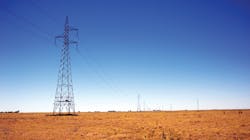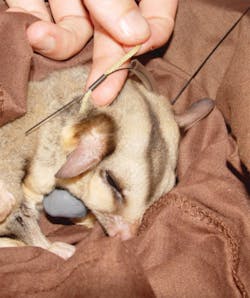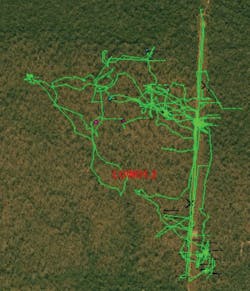Australia Adapts to Land Maintenance Challenges
The Queensland portion of the electricity system supporting Australia’s modern economy and lifestyle is experiencing change on an unprecedented scale. The transformation is being driven by customers embracing new technologies, taking control of their energy use and the shift to a low-carbon economy, according to Electricity Network Transformation Roadmap: Final Report by Energy Networks Australia (ENA) and The Commonwealth Scientific and Industrial Research Organisation (CSIRO). Regulators expect transmission network entities to keep downward pressure on prices and, where possible, reduce their portion of the electricity bill for consumers. This places pressure on budgets allocated for land maintenance.
At the same time, landholders directly affected by transmission network assets have increasing expectations of linear infrastructure providers to mitigate and compensate them for associated impacts. Safety and environmental regulations also are driving utilities and their service providers to consider the implications of land maintenance work in more detail than ever before. Subsequently, utilities want risks quantified and services valued, including those associated with the maintenance of land assets. Land maintenance includes vegetation management, fire risk management, access maintenance, biosecurity control measures, landholder and stakeholder liaison, and co-use management of easement.
The following analysis of case studies by Powerlink Queensland highlights some of the challenges facing transmission network utilities in Australia and how they are responding. They are examples and may not be representative of broader issues experienced across the country.
Focus on Vegetation
Land assets, which facilitate transmission networks across Australia, have different standards and requirements. ENA has focused considerable resources on providing member organizations with guidance on managing their land assets, concentrating heavily on vegetation management in recent years.
The 2008 ENA Land Management Guidelines were developed to assist in providing performance criteria for electricity networks. These guidelines were particularly useful for distribution networks that did not have performance criteria imposed through planning instruments and needed guidance for staff, contractors and regulators.
As a transmission network business, Powerlink has performance criteria set through various planning instruments. However, land management guidelines have assisted with providing a common language nationally and negotiating updates for state codes of practices. Harmonization of requirements for maintenance practices associated with land assets remains an objective of ENA, particularly for vegetation management.
Vegetation communities across Australia have adapted to extremes in weather conditions and ancient soils. In many instances, their very survival relies on fire being present in the landscape, which poses challenges for transmission assets.
In most Australian vegetation communities, increasing levels of disturbance result in an increase in pioneer species regenerating. Powerlink aims to manage vegetation by selectively removing incompatible species and applying registered herbicides where landholders permit their use. This method is adaptive across changes in landscapes and land use, provided the herbicide use does not conflict with the land use.
Selective removal of undesirable species provides environmental benefits — as well as cost-effective and safe management of vegetation — from the improved habitat for wildlife movement across easements, according to M. Goosem in a paper, The Effect of Canopy Closure and Road Verge Habitat on Small Mammal Community Composition and Movements, published in 2000. In a report prepared for Powerlink, Goosem and C.L. Pohlman also confirmed the edge effects on vegetation close to transmission lines were less than those associated with roads following Tropical Cyclone Larry in 2006. This was primarily attributed to the retention of compatible species that effectively closed the edge of the forest to wind bursts.
Over-canopy spanning portions through the Wet Tropics management area has been largely successful, though designing for the mature height of vegetation has not always been precise. This has resulted in high cost and risk vegetation management being required in remote locations to prune or remove vegetation that breached exclusion zones. It highlights the difficulties in over-canopy transmission line design, which often is exacerbated by elevated fire risks.
Reducing Fire Risks
While fire is a natural part of the Australian landscape, it poses additional risks for land assets near transmission lines. When combined with urban expansion into the fringe of bushlands, the risk of fire causing catastrophic outcomes could increase without a coordinated approach with landholders and emergency services. Powerlink’s long-standing involvement in the State Interdepartmental Committee on Bushfires and the Queensland Fire and Biodiversity Consortium are vital in collaborating to improve the management of fire risks in conjunction with joint land maintenance.
The risk of fire in Queensland from weather conditions historically has been lower than southern parts of Australia, where there is high rainfall and humidity in the summer. Proactive vegetation management and fire risk management further lowers the risk profile for Powerlink’s transmission network.
Fires also can impact transmission networks, particularly in causing network outages. Powerlink’s coordinated efforts with stakeholders have helped to improve asset protection and consider biodiversity outcomes from prescribed burns.
In addition, the utility completes fuel load assessments as part of its land inspections, which are performed every two and a half years on average. Bushfire-prone areas are identified through state government planning data sets, which are used primarily for informing town planning decisions (for example, implementing control measures where developments are planned next to bushlands). Sometimes fuel load reductions are undertaken when fire weather conditions and fuel loads warrant the investment. Follow-up selective herbicide application is needed for this to be an effective treatment that modifies species composition.
Arboreal Marsupials
Removal of incompatible species and managing fuel loads results in modified ecosystems, which impact arboreal species. Creating breaks in the canopy creates islands for arboreal species movement, which can result in increased predation. The extent of these impacts has been supplemented by research and the introduction of mitigation measures.
M. Brady and R. Baxter of the University of Queensland and B.D. Taylor and R.L. Goldingay in Australian Mammalogy confirmed selective use of installed poles and nesting boxes by different arboreal species, including mahogany gliders (Petaurus gracilis) and squirrel gliders (Petaurus norfolcensis). Powerlink has installed and trialed different mitigation measures, which then has been supported by research and monitoring. This included support following Tropical Cyclone Yasi in 2011 to understand the impacts on local communities of mahogany gliders.
Biosecurity Threats
As linear assets that traverse the landscape, transmission lines cross catchment, electoral, property and vegetation community boundaries. While not responsible for introducing biosecurity threats into the country, transmission network utilities face the challenge of not contributing further to the spread of threats to ecological, agricultural and economic systems.
In the Feral Future: The Untold Story of Australia’s Exotic Invaders, author Tim Low stated, “Exotic invasions, because they are irreversible and cumulative, deserve to be taken more seriously. More than 2700 weeds have become established in Australia so far, at a cost to the economy of more than $3 billion… What makes our pest problems unique is the way in which so many of them were deliberately created… Of our 18 worst environmental weeds, 17 were intentionally imported.”
Powerlink has a long-established network of vehicle clean-down facilities that supplement public and private facilities. In 2005, Powerlink’s design parameters with stakeholders were shared across the state and investments were made into public clean-down facilities for broader public benefit.
Research on the efficacy of clean downs has discovered weed seed buildup on vehicles depends on the season, vehicle design, type of clean down, duration of the clean down and type of soil traversed. Clean-down facilities with fixed jets were only found to be effective as a loosening process, requiring additional hand cleaning to remove all weed seeds. Mud with high clay content took 20 minutes to remove all foreign material, while mud with high sand content achieved similar results in five minutes.
A review of clean-down facilities required across the state is underway, taking into consideration the use, proximity to changes in biosecurity threats, availability of alternative clean-down facilities and community priorities. The review is designed to coincide with process changes to implement consistent record keeping and risk management.
As part of Powerlink’s expansion into the Surat Basin, to meet customer demand for energy as part of coal seam gas extraction, biosecurity concerns from the community rose to the surface as a key issue. While few weeds existed in the area, the concern was construction activities and ongoing maintenance would increase the risk of new threats being introduced.
Powerlink addressed community concerns by grouping zones with common biosecurity threats to consolidate control measures and facilitate timely construction of transmissions assets.
A review of biosecurity risks at a landscape level and associated control measures are underway following legislative changes in 2014. Current control measures have evolved based on landholder concerns that continue to become more complex over time. A landscape approach is needed to consolidate control measures based on science and risk, while engaging with landholders and the broader community.
Ancient Erosive Soils
As part of the Australian State of the Environment report in 2016, authors P. Kanowski and N. McKenzie described most of Australia’s soils as ancient, strongly weathered and infertile. “Surface layers have low levels of organic matter and are often poorly structured… These constraints and their interactions with climate have made it difficult to develop sustainable systems of land use,” the authors stated.
Linear corridors transecting these soils typically are in steeper terrain to avoid impacts on urban communities and reduce construction costs. Access tracks typically are designed for dry weather four-wheel-drive standard, minimizing ground disturbance wherever possible. However, access in wet weather conditions sometimes is necessary, which leads to damage to access and erosion. Repair work is necessary, which is grouped into refurbishment work if it is beyond maintenance programs.
Water crossings typically are bed-level crossings to limit impacts on native fish movements, but they pose safety risks for staff and contractors who access them immediately after rainfall. The combined risks of traversing access tracks in wet weather conditions has resulted in increased use of helicopters to assess asset conditions immediately after extreme weather events. Use of remote-sensing technologies is being assessed potentially to further reduce the need for accessing assets on the ground and contribute to reductions in erosion.
Other Challenges
Field delivery teams are presented with many challenges in maintaining land assets. From an asset management perspective, Powerlink is collecting more asset condition data than ever before to better understand and manage its risks. Improved asset condition data is essential for prioritizing land maintenance with constrained budgets; however, increasingly, the utility is exploring automated digital solutions to help make informed investment decisions.
Land use can help or hinder the maintenance of land assets associated with transmission networks. This includes co-use issues that need to be identified and managed based on risk. Managing an activity that could be incompatible with transmission land assets is the utility’s objective, but this relies on landholders notifying Powerlink of its intentions. In some instances, easements have become so encumbered with issues that securing a new easement is the only viable option. Support from the local government in managing potential co-use issues through planning approvals is essential, but this varies across the state.
Landholders are increasingly placing conditions on entry onto their properties, regardless of easement terms and conditions. In 2014, Powerlink developed a land access protocol in response to increased interest from landholders in the Surat Basin. Stakeholders more broadly need to be identified, prioritized and engaged with. By consciously and proactively doing so, Powerlink aims to improve its social license to operate. Traditional owners are considered in a similar way to landholders and are engaged with the same team within Powerlink.
Baseline data for monitoring ecological performance has been established for a selection of sites within protected areas, based on a report by Goosem and Pohlman, Rapid Assessment of Environmental Monitoring Sites: Powerlink Queensland Easements. These monitoring sites provide reference for how much land maintenance practices have changed the species composition over time. A review of these sites has not been a priority since the initial baseline data was captured, but rather the true benefits will be in monitoring changes over longer periods of time.
Powerlink has invested directly and indirectly into research associated with land assets. This has resulted in a greater depth of understanding not only by the utility but also the research community on potential impacts from transmission networks. In many instances, this understanding has enabled smoother project approvals, agreements on codes of practice and improved relationships with protected area management.
Powerlink has considered strategic, program, operational, execution and monitoring elements of its land maintenance by reviewing these against the ENA and AFAC national guidelines. The review identified opportunities for improvements, which have formed part of the utility’s continual improvement of land maintenance.
A Holistic Approach
These case studies demonstrate an indication of the diversity of issues that need to be managed in association with transmission network land assets. The review performed against national guidelines highlighted the need for issues to be considered and managed from a strategic, program, operational, execution and monitoring perspective to be successful. While issues in Australia have some unique aspects, the need for a holistic approach to be effective is a universal learning for all those managing transmission network land assets.
Powerlink balances the requirements of stakeholders to manage land assets based on the risks and priorities. Economic regulators and energy consumers expect cost reductions to be realized, while landholders and other regulators expect increasing levels of diligence. Powerlink is well positioned and responding to the challenges of managing transmission network land assets.
Five Biosecurity Threats to Powerlink’s System
As linear assets that traverse the landscape, transmission lines cross catchment, electoral, property and vegetation community boundaries. While not responsible for introducing biosecurity threats into the country, network businesses face the challenge of not contributing further to the spread of threats to ecological, agricultural and economic systems. Following are some species-specific case studies in Queensland, Australia.
1. Common weeds. Parthenium hysterophorus is now a common weed across large sections of central Queensland with scattered outbreaks in other parts of the state. The attributes of the seeds mean they have a high risk of being carried by moving vehicles. Because it is an annual plant, detecting its presence is difficult at certain times of the year. Powerlink considers the presence of the weed whenever expanding the network, focusing on avoiding any infested areas. Eradication in densely infested areas is not considered feasible by regulators, as various programs have failed to remove the plants from the landscape once introduced. Where outbreaks are scattered, there is a coordinated approach to eradicate the weed. Powerlink has supported the broader efforts of the community.
2. Panama disease. Fusarium oxysporum has recently been detected in tropical north Queensland and has the potential to drastically reduce banana production, by a fungus entering the plants through their root systems and blocking the vascular system. Once present in the soil, the fungus cannot be eradicated and can survive in the soil for decades without host plants. The biosecurity threat spreads easily by movement of contaminated soil, water and plant material. Powerlink has transmission network assets in the general area, but none where the Panama disease has been discovered. Powerlink’s clean-down facility in the area has become an essential part of the containment program, enabling regulators to clean vehicles and equipment before leaving the area. Biosecurity Queensland has acknowledged Powerlink for its contribution in the containment efforts.
3. Fire ants. Solenopsis invicta first were discovered in Australia in 2001 in southeast Queensland. The state government established a detection and eradication program with specific regulatory provisions to support the efforts of detecting and eradicating this threat, which Powerlink supported. As a government-owned utility, key staff were training as inspectors with the ability to declare material fire ant free and send samples of ants for possible detection. Biosecurity Queensland soon discovered the extent of fire ants was far from isolated and established management zones around the nest areas that were found and treated. Since 2001, Powerlink has detected several outbreaks near transmission network assets, which have been reported to Biosecurity Queensland. This has triggered rapid responses and treatments with ongoing monitoring to determine if the treatments were successful. The management of fire ants as a biosecurity threat now is integrated into the broader biosecurity regulation. While the program has been successful in containing and restricting the spread of fire ants in Australia, the initial plan of eradication has not been realized yet.
4. Siam weed. Chromolaena odorata first were discovered in Australia in 1994 in tropical north Queensland. Some occurrences of Siam weed have been found near Powerlink transmission network assets, and Powerlink has supported the coordinated efforts of Biosecurity Queensland and the local government to detect and eradicate the weed. With a similar form to Lantana camara , which has been long established in Australia, it is thought the Siam weed was present long before it was detected. This is supported from survey results coordinated by Biosecurity Queensland, which established its presence across large areas of northern Queensland following its initial detection. Based on these survey results, plans to eradicate Siam weed were reevaluated and the focus is now on containment.
5. Candy leaf. Stevia ovata was discovered in north Queensland. Powerlink supported investigations into its origins as well as the subsequent control measures to contain its occurrence in the landscape.
About the Author
Stephen Martin
Stephen Martin currently serves as a land strategist for Powerlink Queensland, which includes setting policy, monitoring performance, liaising with stakeholders, and identifying efficiencies during a period of significant change. He is actively involved in knowledge sharing, as demonstrated by his involvement in various industry bodies, such as the ENA's vegetation management working group.


